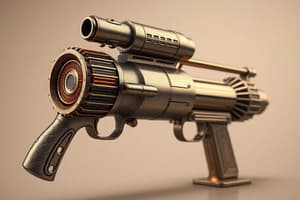Podcast
Questions and Answers
Which of the following materials is commonly used in PBF processing for producing high density structures?
Which of the following materials is commonly used in PBF processing for producing high density structures?
- Wood
- Nylon Polyamide (correct)
- Aluminum
- Glass
LPS involves the complete melting of all powder constituents during processing.
LPS involves the complete melting of all powder constituents during processing.
False (B)
What role does Co (cobalt) play in LPS used for forming cemented carbide cutting tools?
What role does Co (cobalt) play in LPS used for forming cemented carbide cutting tools?
It acts as a lower-melting-point constituent to glue together WC particles.
In PBF processing, the thermal energy is generally sufficient to _____ a portion of the previously solidified solid-structure.
In PBF processing, the thermal energy is generally sufficient to _____ a portion of the previously solidified solid-structure.
Match the materials with their corresponding types used in powder processing:
Match the materials with their corresponding types used in powder processing:
Which binding mechanism involves fully melting metallic powder?
Which binding mechanism involves fully melting metallic powder?
Indirect processing uses solely metallic powder for part construction.
Indirect processing uses solely metallic powder for part construction.
Name one process utilized for creating ceramic parts.
Name one process utilized for creating ceramic parts.
The required laser power typically increases with the melting point of the material and lower powder bed temperature, influenced by the material's __________ characteristics.
The required laser power typically increases with the melting point of the material and lower powder bed temperature, influenced by the material's __________ characteristics.
Match each process with its description:
Match each process with its description:
Which parameter influences both the required laser power and the powder bed temperature?
Which parameter influences both the required laser power and the powder bed temperature?
Scan related parameters include laser power and pulse duration.
Scan related parameters include laser power and pulse duration.
How many galvanometers are typically included in a PBF machine?
How many galvanometers are typically included in a PBF machine?
Which mode involves scanning the outline of the part cross-section for accuracy and surface finish reasons?
Which mode involves scanning the outline of the part cross-section for accuracy and surface finish reasons?
In fill mode, the entire cross-section is scanned with a specific direction for residual stresses.
In fill mode, the entire cross-section is scanned with a specific direction for residual stresses.
What are two challenges in powder handling for PBF?
What are two challenges in powder handling for PBF?
The lack of a single solution for powder delivery includes the use of the __________ roller in PBF.
The lack of a single solution for powder delivery includes the use of the __________ roller in PBF.
Match the characteristics of powder feeding systems with their descriptions:
Match the characteristics of powder feeding systems with their descriptions:
What is one of the universal characteristics of powder feeding?
What is one of the universal characteristics of powder feeding?
Powder delivery systems must create excessive shear forces to ensure previously processed layers are not disturbed.
Powder delivery systems must create excessive shear forces to ensure previously processed layers are not disturbed.
Name one type of scan pattern used in the applied energy calculations.
Name one type of scan pattern used in the applied energy calculations.
Which type of laser is primarily used in the Polymer Laser Sintering (pLS) process?
Which type of laser is primarily used in the Polymer Laser Sintering (pLS) process?
Thermoset polymers are typically processed using Powder Bed Fusion (PBF).
Thermoset polymers are typically processed using Powder Bed Fusion (PBF).
What is the typical thickness of the powder layers in the pLS process?
What is the typical thickness of the powder layers in the pLS process?
The Powder Bed Fusion process uses _____ to induce fusion between powder particles.
The Powder Bed Fusion process uses _____ to induce fusion between powder particles.
Match the following materials with their properties:
Match the following materials with their properties:
Which of the following materials is NOT commonly processed using Powder Bed Fusion?
Which of the following materials is NOT commonly processed using Powder Bed Fusion?
In the pLS process, the part building occurs in an environment filled with oxygen.
In the pLS process, the part building occurs in an environment filled with oxygen.
What happens to the build platform after completing a layer in the pLS process?
What happens to the build platform after completing a layer in the pLS process?
The SLS process originally developed for producing _____ prototypes.
The SLS process originally developed for producing _____ prototypes.
Which characteristic is common among all Powder Bed Fusion processes?
Which characteristic is common among all Powder Bed Fusion processes?
What is true about the interaction between an electron beam and gas?
What is true about the interaction between an electron beam and gas?
Laser beams are unaffected when passing through transparent gases at their wavelength.
Laser beams are unaffected when passing through transparent gases at their wavelength.
What type of environment is EBM typically practiced in?
What type of environment is EBM typically practiced in?
During part building in polymer PBF, loose powder acts as a sufficient support material, saving ___ during part building and post-processing.
During part building in polymer PBF, loose powder acts as a sufficient support material, saving ___ during part building and post-processing.
Match the following PBF process benefits and drawbacks:
Match the following PBF process benefits and drawbacks:
What is a common outcome of using larger powder particle sizes in PBF?
What is a common outcome of using larger powder particle sizes in PBF?
The future of PBF technology does not look promising for additive manufacturing.
The future of PBF technology does not look promising for additive manufacturing.
The presence of beam traces in the final microstructure is dependent on process parameters and ___ material.
The presence of beam traces in the final microstructure is dependent on process parameters and ___ material.
Which material is the most popular for Polymer Laser Sintering (pLS)?
Which material is the most popular for Polymer Laser Sintering (pLS)?
Electron Beam Melting (EBM) uses lasers to fuse metal powder particles.
Electron Beam Melting (EBM) uses lasers to fuse metal powder particles.
What is one of the limitations of Polymer Laser Sintering (pLS) machines?
What is one of the limitations of Polymer Laser Sintering (pLS) machines?
The machines designed for Polymer Laser Sintering (pLS) are commonly called ___ or ___.
The machines designed for Polymer Laser Sintering (pLS) are commonly called ___ or ___.
Match the following PBF processes with their primary characteristics:
Match the following PBF processes with their primary characteristics:
What differentiates Electron Beam Melting (EBM) from laser-based systems?
What differentiates Electron Beam Melting (EBM) from laser-based systems?
3D Systems' low-temperature machines can only process nylon materials in Polymer Laser Sintering (pLS).
3D Systems' low-temperature machines can only process nylon materials in Polymer Laser Sintering (pLS).
In Electron Beam Melting, the electron beams move at a speed close to the ___ of light.
In Electron Beam Melting, the electron beams move at a speed close to the ___ of light.
Flashcards
LPS
LPS
The fusion of powder particles where some constituents melt, acting as glue to bind solid particles together.
Full Melting in AM
Full Melting in AM
A fusion mechanism where the entire region of material exposed to heat melts, creating a dense and well-bonded structure exceeding the layer thickness.
PBF Processing
PBF Processing
A method for creating 3D objects by selectively melting powder layers with a laser or electron beam.
Engineering Alloys in AM
Engineering Alloys in AM
Signup and view all the flashcards
Semi-Crystalline Polymer in AM
Semi-Crystalline Polymer in AM
Signup and view all the flashcards
Powder Bed Fusion (PBF)
Powder Bed Fusion (PBF)
Signup and view all the flashcards
PBF Characteristics
PBF Characteristics
Signup and view all the flashcards
How does pLS work?
How does pLS work?
Signup and view all the flashcards
pLS Process Steps
pLS Process Steps
Signup and view all the flashcards
pLS Environment
pLS Environment
Signup and view all the flashcards
pLS Materials
pLS Materials
Signup and view all the flashcards
Metal PBF
Metal PBF
Signup and view all the flashcards
Ceramic PBF
Ceramic PBF
Signup and view all the flashcards
Amorphous Polymers
Amorphous Polymers
Signup and view all the flashcards
Crystalline Polymers
Crystalline Polymers
Signup and view all the flashcards
Contour Mode
Contour Mode
Signup and view all the flashcards
Fill Mode
Fill Mode
Signup and view all the flashcards
Powder Handling Challenges
Powder Handling Challenges
Signup and view all the flashcards
Powder Size Impact
Powder Size Impact
Signup and view all the flashcards
Counter-Rotating Roller
Counter-Rotating Roller
Signup and view all the flashcards
Powder Reservoir
Powder Reservoir
Signup and view all the flashcards
Powder Transport
Powder Transport
Signup and view all the flashcards
Powder Spreading
Powder Spreading
Signup and view all the flashcards
Full Melting PBF
Full Melting PBF
Signup and view all the flashcards
Liquid-Phase Sintering PBF
Liquid-Phase Sintering PBF
Signup and view all the flashcards
Indirect PBF
Indirect PBF
Signup and view all the flashcards
Pattern PBF
Pattern PBF
Signup and view all the flashcards
Direct Sintering in Ceramics
Direct Sintering in Ceramics
Signup and view all the flashcards
Chemically-Induced Sintering in Ceramics
Chemically-Induced Sintering in Ceramics
Signup and view all the flashcards
Laser Power Factors
Laser Power Factors
Signup and view all the flashcards
Scan Parameters in PBF
Scan Parameters in PBF
Signup and view all the flashcards
Polymer Laser Sintering (pLS)
Polymer Laser Sintering (pLS)
Signup and view all the flashcards
pLS vs. Laser Sintering (LS)
pLS vs. Laser Sintering (LS)
Signup and view all the flashcards
EBM's Heat Source
EBM's Heat Source
Signup and view all the flashcards
EBM vs. SLM
EBM vs. SLM
Signup and view all the flashcards
Why is pLS good for Indirect Processing?
Why is pLS good for Indirect Processing?
Signup and view all the flashcards
Electron Beam (EBM)
Electron Beam (EBM)
Signup and view all the flashcards
Laser Beam
Laser Beam
Signup and view all the flashcards
Electron Beam Melting (EBM)
Electron Beam Melting (EBM)
Signup and view all the flashcards
Laser Powder Bed Fusion (LPBF)
Laser Powder Bed Fusion (LPBF)
Signup and view all the flashcards
Partial Melting in PBF
Partial Melting in PBF
Signup and view all the flashcards
PBF Process Benefits
PBF Process Benefits
Signup and view all the flashcards
PBF Process Drawbacks
PBF Process Drawbacks
Signup and view all the flashcards
Powder Particle Size in PBF
Powder Particle Size in PBF
Signup and view all the flashcards
Thermal Conductivity in PBF
Thermal Conductivity in PBF
Signup and view all the flashcards
Study Notes
Chapter 5: Powder Bed Fusion Processes
- Powder bed fusion (PBF) is a 3D printing process
- Focuses on the fusion of powder particles
- SLS is a type of PBF
- First commercialized PBF process: Selective Laser Sintering (SLS)
- Developed at the University of Texas at Austin
- Other PBF processes use different techniques to enhance machine productivity or avoid specific patented features
- All PBF processes share basic characteristics:
- One or more thermal sources to fuse powder particles
- A method to control powder fusion to a specific layer
- Mechanisms to add and smooth powder layers
Objectives
- Discuss powder bed fusion processes
- Describe the Selective Laser Sintering (SLS) process
- Examine the different materials used
- Explore powder fusion mechanisms
- Investigate process parameters and modeling
- Analyze powder handling
- Discuss PBF process variants
- Look at different types of commercial machines
Materials
- Polymers and composites
- Thermoset polymers are typically not processed into parts using PBF due to degradation
- Thermoplastics are used because they do not degrade
- Amorphous polymers have random molecular structures
- Crystalline polymers have a regular molecular structure
- Metals and composites: Steel, stainless steel, tool steels, titanium, nickel, some aluminum alloys, and cobalt-chromium are all used in PBF
- Ceramics and ceramic composites: Metal oxides, carbides, and nitrides are commonly used
Powder Fusion Mechanisms
- Four types of fusion mechanisms:
- Solid-state sintering: Powder fusion without melting at elevated temperatures
- Chemically induced binding: Powder fusion via chemical reactions between powders and atmospheric gases
- Liquid-phase sintering and partial melting: A portion of the powder melts, acting as a glue to bind other particles
- Full melting: The material is fully melted using a high energy laser or electron beam
Process Parameters and Modeling
- Laser processing parameters: Laser power, spot size, pulse duration, pulse frequency, and others
- Powder-related parameters: Particle shape, size, distribution, powder bed density, layer thickness, and material properties
- Temperature-related parameters: Powder bed temperature, powder feeder temperature, temperature uniformity, etc
Powder Handling
- Powder handling challenges: Powder delivery systems, powder recycling, and maintaining powder quality
- Any powder delivery system must meet certain characteristics, including having sufficient reservoir volume and being capable of accurately transporting and spreading powder thinly
PBF Process Variants and Commercial Machines
- Polymer laser sintering (SLS or LS): Using CO2 lasers and low temperatures
- Laser-based systems for metals and ceramics: Using different lasers and more sophisticated systems such as Nd-YAG lasers
- Electron beam melting (EBM): High-energy electron beam, low pressure environments
- Line-wise and layer-wise PBF processing methods: Specific approaches for processing different materials or improving accuracy
Process Benefits and Drawbacks
- PBF can process a wide variety of materials
- Saves time during part building and post-processing, which is particularly true in polymer processing
- Accuracies are generally lower than liquid-based processes; Materials with low thermal conductivity provide more accurate parts and lower shrinkage amounts
Exercises
- Examples of Arrhenius equation applications to solid-state sintering
- Energy driving force differences in different powder beds
- Advantages and disadvantages of binder and structural material alternatives for bone tissue scaffold application in Liquid-Phase Sintering (LPS) for bone-tissue scaffolds
- Examination of powder characteristics and handling using standard kitchen ingredients
- Examination of parameter limitations for nylon polyamide in laser sintering
- Estimating the minimum laser dwell time for maintaining a type B scan track in applied energy calculations
Studying That Suits You
Use AI to generate personalized quizzes and flashcards to suit your learning preferences.




